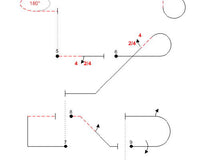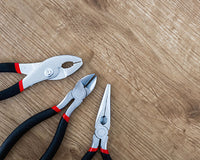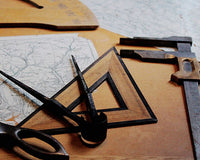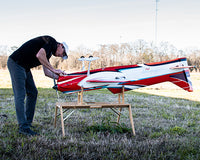This article is written by CK Aero Co-Founder Brett WIckizer
When I lived in Austin, Texas my good friend Rene Grebe organized a pattern primer event for our area. He invited me to come and speak a few times, to share my knowledge for the benefit of the less experienced. The following is based on what I presented there but there are countless very experienced, very talented pilots who could benefit in some way from reading. It’s a loose collection of personal observations and tidbits of information that I’ve gathered over the years but I think it’s valuable nonetheless. I encourage even the most seasoned of you out there to take a look – sometimes my most egregious errors and my worst tendencies are rooted in fundamental mistakes.
"sometimes my most egregious errors and my worst tendencies are rooted in fundamental mistakes."
All maneuvers start and end with a straight line flown parallel to the runway with wings level. However, in my experience, as long as you demonstrate a straight and level portion of some observable length, you will not be downgraded. That goes for establishing a straight line before and after roll segments in your maneuvers as well. The more clearly you present a straight line the shorter that line can be. Use this fact to your advantage on maneuvers where adequate space is a challenge.
All maneuvers must be wind corrected to preserve their geometry. You should have a very clear idea of which way the wind is blowing when you take off, and keep that in mind for the first few maneuvers. Correct based on what you think the wind should be doing then adjust from there throughout your flight. Be smart about the distance you start your flight; if you have a strong inblowing crosswind start a little farther out than normal and vice versa. The better you get at reading the wind before you take off the better this technique works.
Rolling through radii should be your primary wind correction technique, not rudder! Rudder should only be used as a fine adjustment.
You must be the most attentive on power off 45’s and verticals, especially at center! This is when you get blown around the most because you are often focused on some element of the line, wind has a greater effect on the aircraft when the thrust of the engine is not helping you out , and it is much harder to see the plane move in or out at center. All of these factors add up to make wind correction especially challenging during power off phases of flight at center.
You usually want to snap into the wind. Although not essential, it will usually be easier to preserve the track of the aircraft.
Always stall turn into the wind, but remember that wind direction can change at altitude. I remember being at the world championships in Portugal and seeing the smoke stacks on top of the hill a quarter of a mile away indicating wind 180 degrees from what we were feeling on the ground! If your airplane is trimmed well it will want to crab itself into the wind, use that indication to decide the stall turn direction.
If flying into a headwind, apply less elevator to achieve the same radius as calm conditions and vice versa for downwind. This is especially important when flying loops because the effect the wind has on the airplane is constantly changing. Don’t be mechanical. Fly the plane, not your thumbs.
All radii in a maneuver must be the same. Maneuvers where this is easy to forget:
- Reverse and Half Reverse Cuban 8’s. Don’t make the entry radius too small! It has to match the radius of your two ¾ loops. It’s a very common mistake I’ve seen made by some of the best pilots in the world in the finals at the world championships!
- Any time you pull or push to a 45 or vertical down line it’s very easy to “drop” into the line and make the entry radius very small.
- End-box top hats have a chronic issue, especially in the lower classes, of very tight radii at the bottom. Make the entry and exit radii slightly smaller and the bottom radii slightly bigger.
- Any time after an extended vertical up line, pilots generally make the radii too small. It is hard to do correctly, especially with an underpowered airplane and when flying into the wind, but make sure to make these radii nice and “full”.
All rolls are centered on the line and roll rates are the same.Avoid the common “roll and pull” on half reverse Cuban 8’s. Make a nicely defined and equal length line after the roll and you will set yourself apart in the lower classes. On 45 up lines remember that you should have to push a little bit to keep the plane on track while inverted. If you don’t have to, you’re probably very tail heavy.
Point rolls must hesitate equal time on each point. Pay attention to the duration of your hesitations. It is better to make your hesitations longer and to roll a little bit quicker. Define those points! The better you get the slower and more graceful you can make the roll while keeping definition in the points. This is why you see all the top pilots flying with slow, graceful rolling elements. In the lower classes it’s much more important to clearly define your points than it is to try and roll slowly.
All center maneuvers should start and finish at the same altitude. If the maneuver takes a long time to get through, a Cuban 8 for example, it is easy to forget what altitude you started at by the end of the maneuver. Try and take a mental snapshot at the beginning of the maneuver for reference at the end. If it’s cloudy, pick a reference cloud in the sky.
Turnaround maneuvers are altitude adjusting and they are not required to begin and finish at the same altitude. Strive to do it anyways. Unless you find yourself too low and you need to adjust your baseline, you should always fly as consistently as possible. This presents better and shows the judge that you are 100% in control.
Lines in a maneuver that have a defined relationship should be the same length – a square loop for example. Some pilots like to count out the length of their lines (“1, 2, pull… 1, 2, pull…” etc.). This technique can be helpful but remember that different groundspeeds will make this ineffective. It’s the length of the lines you’re worried about not the time it takes to fly them. Pay close attention to this on the down leg of stall turns because the airplane is always accelerating.
Stall Turns should have a maximum pivot displacement of one half wing span for no downgrade in the AMA classes (FAI should have no displacement). In practice you should strive to pivot around the CG of the airplane. Assuming the airplane is setup well enough, it’s possible to rotate around the CG even in dead calm conditions. In competition, you may want to give yourself more room for error because a flopped stall turn is always worse than a one or two point downgrade.
Unless there is a decent crosswind, keep the motor 2-4 clicks above idle to get the pivot started. Once the plane starts to pivot pull back to idle and take out most of your rudder input. To prevent the tail wag at the end of the stall, hold a tiny amount of rudder in until you know the airplane is stable. In a crosswind, it’s usually better to use opposite rudder to do this and in calm conditions it’s usually better to use same direction rudder (relative to the rudder you used to do the stall turn). Experiment with this and see what you find.
Final notes for beginners who want to advance through the classes:
Learn to use the left side of the transmitter now, not later. Rudder and throttle control is the real separator past advanced. Pay close attention to the throttle management and smooth rudder inputs of the best masters and F3A pilots and try to do the same. I could write a book about this. I just cannot stress the importance of learning these things early on enough.
Learn to roll correctly, which means blending rudder and elevator in and out throughout the roll. This is something that a simulator can be especially helpful with. It might feel like a pain in the butt now, but try getting through the masters or F3A sequence without rolling with your rudder and you’ll face a much bigger headache than you can handle! Remember that you should always use rudder when you roll (this includes half, quarter, etc. rolls as well) even if you just have to breathe on it on a 45 down line. The best way to practice this is to start with a 4 point roll. Get comfortable with the amount and direction you have to move the stick for each attitude of the airplane. Go to a 2 point roll next and try to blend the rudder and elevator so the altitude and heading of the airplane remains constant (remembering to make your pauses long and defined). Eventually bring it all together and you’ll be a slow rolling machine.
Now is the time to build the basics of your pattern flying. Small annoyances like fixing wrong rudder inputs, learning to roll with rudder, long hesitations on points, etc. will pay huge dividends when you start flying the more complex sequences. I’ve seen so many pilots become frustrated after being in pattern for a couple years because they didn’t engrain the basics in their head and thumbs in the beginning. They hit a plateau in advanced or even intermediate and can’t move forward because they’ve just been “getting by”. While this may result in better scores for your first few contests it will come back to haunt you later. Think of it like cheating your way through high school, being admitted to MIT, then failing miserably because you didn’t learn anything! Do it right and pattern can be the most rewarding flying experience you’ve ever had.












